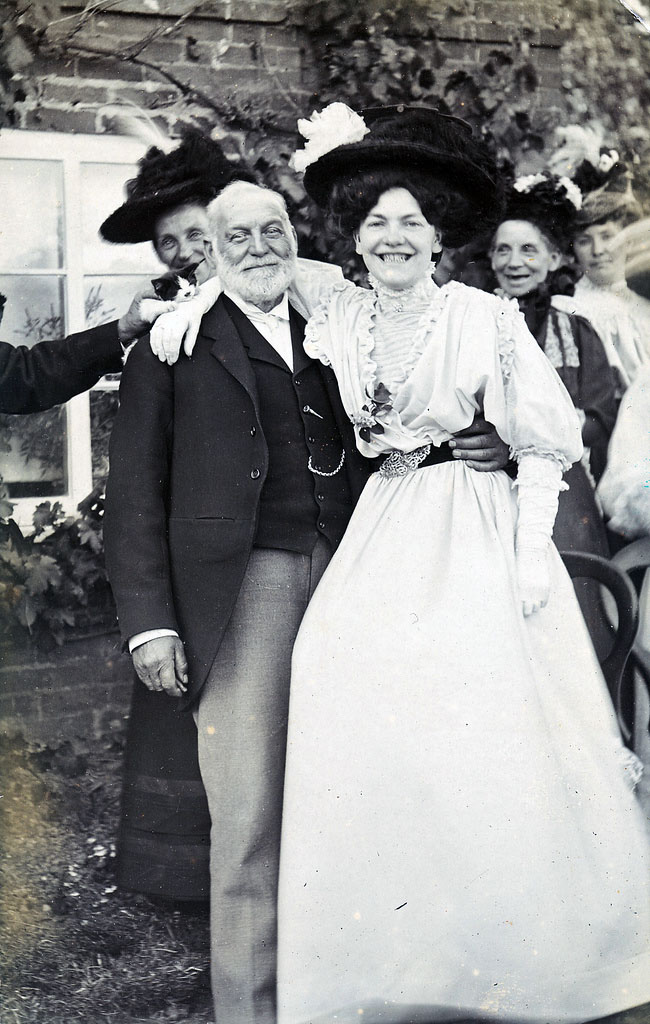
When Joseph-Nicephore Niepce took the first photograph in 1828, his photographic plate required an exposure of eight hours. That exposure time was drastically reduced across the course of the nineteenth century, so that by the 1890s the Collodion process had cut exposure times to two or three seconds.
Nevertheless, a three second exposure meant that subjects had to stand very still to avoid being blurred, and holding a smile for that period was tricky. As a result, we have a tendency to see our Victorian ancestors as even more formal and stern than they might have been.
These pictures are drawn from the Flickr group “The Smiling Victorian” and show a perhaps surprising side to the people who’s “now” was a hundred years before our own.
…..
Thank you very much to all the members of The Smiling Victorian group.
































fantastic…the little boy with the horse is just so sweet! nice to see some warmth…it’s true, so many victorian images are cold and seem to lack any kind feelings at all…but these show us other wise.
I sometimes wonder just how much those stern, emotionless pictures have distorted our collective view of the past. Could they perhaps have contributed to much of the 20th century desire to break all ties with history and insist that ours are better, happier times? Not saying that they aren’t, but could part of the idealisation of the 60s be because it was the first period to usher in a glut of pictures of people actually enjoying themselves, and in colour!
As an aside, it’s not just photography that may be to blame, paintings require a far longer sitting period and Leonardo is universally praised for being able to effectively capture a smile with his brushwork.
They might not be in colour, but we have lots of family photos of people enjoying themselves between the wars.
There’s always something good on here!
Absolutely wonderful! A rare and fabulous find, thank you
Any chance of turning these gorgeous photographs into a book? I would buy it!
Biggles, I think you’re onto something. Something about a smiling face breaks the time barrier.
Wow. My family has tons of pictures from that time and they all look like they are waiting to be stuffed. It wasn’t until about 1920 or so that they start acting more natural. Coincidentally that was when they had their own camera and pictures were no longer formal posed portraits taken at studios.
No one smiled for the painted portraits either. I think they thought it made them look silly and we think it makes them look like they are alive. Perspective.
Oh, this is wonderful! Mr. Biggles, your first sentence is a very thought-provoking one and not without merit. However, there are many examples of happy, laughing people taken prior to the 1960’s (good heavens, you must be very young!)but your point is well-taken. The typical image of a Victorian is a dour, rigid, somewhat prim one (unless, of course, one were to actually crack open a book written in that time and then, well, so much for the accuracy of photography, but I digress.)
While each photo is a delight, I particularly love the second one. Look how serious the couple seems in the first shot (very much like the majority of portraits you see of that time) and then he just can’t resist himself and starts to grab her and you can almost hear her giggling, can’t you? Thank you for another amazing glimpse into the past.
Nice to see an alternative view of the stereotype. Enjoyable photos and comments too. Good one!
Judging by the dates (and the fashions on the undated ones) these are mostly Edwardian, not Victorian.
A very pleasant change from the usual dour visages of our ancestors. Thanks
Biggles - quite so. At the heart of being a Retronaut is the realisation that our collective view of the past is false. Even the word “past” is false. No-one has ever lived in the “past” nor will they. Everyone has lived in “now”, just as we live “now”.
It is of course true that our technology changes, and that includes the intellectual frameworks we use to operate in. At the same time, the experience of being alive as a person remains almost exactly constant. To the degree that we see the people who have lived before us as different to us, to that degree is our view of time distorted.
“The poetry of history lies in the quasi-miraculous fact that once, on this earth, once, on this familiar spot of ground, walked other men and women, as actual as we are today, thinking their own thoughts, swayed by their own passions, but now all gone, one generation vanishing into another, gone as utterly as we ourselves shall shortly be gone, like ghosts at cockcrow.”
- GM Trevelyan
I always have to remind myself that no matter how modern things seem to be in this day and age, in ten years time they will seem quaint, and in 20 will be ancient history (and after 21 will be revived selectively in a fit of fashionable nostalgia)